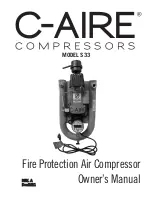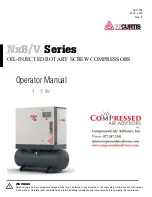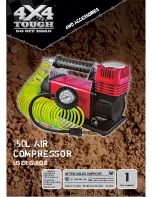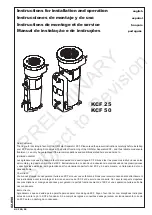
GB
7
WARNING: Not using protective equipment or appropriate clothing can cause personal injury
or increase the severity of an injury.
10. Connect dust extraction equipment - If the tool is provided for the connection of dust
extraction and collecting equipment, ensure these are connected and properly used
11. Do not abuse the power cable - Never yank the power cable to disconnect it from
the socket. Keep the power cable away from heat, oil and sharp edges. Damaged or
entangled power cables increase the risk of electric shock
12. Secure work - Where possible use clamps or a vice to hold the work. It is safer than
using your hand
13. Do not overreach - Keep proper footing and balance at all times
14. Maintain tools with care
- Keep cutting tools sharp and clean makes the tool easier to control and less likely to bind
or lock in the workpiece
- Follow instruction for lubricating and changing accessories
- Inspect tool power cables periodically and if damaged have them repaired
by an
authorized service facility
- Inspect extension cables periodically and replace if damaged
- Keep handles dry, clean and free from oil and grease
WARNING: Many accidents are caused by poorly maintained power tools.
15. Disconnect tools - When not in use, before servicing and when changing
accessories such as blades, bits and cutters, disconnect tools from the power supply
WARNING: The use of accessories or attachments not recommended by the manufacturer
may result in a risk of injury to persons.
16. Remove adjusting keys and wrenches - Form the habit of checking to see that
keys and adjusting wrenches are removed from the tool before switching it on
17. Avoid unintentional starting - Ensure switch is in "off' position when connecting to
a mains socket or inserting a battery pack, or when picking up or carrying the tool
WARNING: Unintended starting of a tool can cause major injuries.
18. Use outdoor extension leads - When the tool is used outdoors, use only extension
cords intended for outdoor use and so marked. Use of an extension cable suitable for
outdoor use reduces the risk of electric shock
19. Stay alert
- Watch what you are doing, use common sense and do not operate the tool when you are
tired
- Do not use a power tool while you are under the influence of drugs, alcohol or medication
WARNING: A moment of inattention while operating power tools may result in serious
personal injury.
20. Check damaged parts
- Before further use of tool, it should be carefully checked to determine that it will operate
properly and perform its intended function
- Check for alignment of moving parts, binding of moving parts, breakage of parts,
mounting and any other conditions that may affect its operation
- A guard or other part that is damaged should be properly repaired or replaced by an
authorized service centre unless otherwise indicated in this instruction manual
- Have defective switches replaced by an authorized service centre
WARNING: Do not use the tool if the on/off switch does not turn it on and off. The switch
must be repaired before the tool is used.
21. Have your tool repaired by a qualified person - This electric tool complies with
the relevant safety rules. Repairs should only be carried out by qualified persons,
otherwise this may result in considerable danger to the user
WARNING: When servicing use only identical replacement parts.
WARNING: If the power cable is damaged it must be replaced by the manufacturer or an
authorised service centre.
22.Power tool mains plugs must match the mains socket - Never modify the plug
in any way. Do not use any adapter plugs with earthed (grounded) power tools.
Unmodified plugs and matching sockets will reduce risk of electric shock
23.If operating a power tool outside use a residual current device (RCD) - Use of an
RCD reduces the risk of electric shock
NOTE: The term “residual current device (RCD)” may be replaced by the term “ground fault
circuit interrupter (GFCI)” or “earth leakage circuit breaker (ELCB)”.
WARNING: When used in Australia or New Zealand, it is recommended that this tool is
ALWAYS supplied via Residual Current Device (RCD) with a rated residual current of 30mA
or less.
WARNING: Before connecting a tool to a power source (mains switch power point receptacle,
outlet, etc.) be sure that the voltage supply is the same as that specified on the nameplate
of the tool. A power source with a voltage greater than that specified for the tool can result in
serious injury to the user, and damage to the tool. If in doubt, do not plug in the tool. Using a
power source with a voltage less than the nameplate rating is harmful to the motor.
Polarised Plugs (for North America only) To reduce the risk of electric shock, this equipment
has a polarized plug (one blade is wider than the other). This plug will fit in a polarized outlet
only one way. If the plug does not fit fully in the outlet, reverse the plug. If it still does not fit,
contact a qualified electrician to install the proper outlet. Do not change the plug in any way.
Air Tool Safety
• For multiple hazards, read and understand the safety instructions before installing,
operating, repairing, maintaining, changing accessories on, or working near this tool.
Failure to do so can result in serious bodily injury
• Only qualified and trained operators should install, adjust, or use this tool
• Do not modify this tool. Modifications can reduce the effectiveness of safety measures
and increase the risks to the operator
• Do not discard the safety instructions; give them to the operator
• Do not use this tool if it has been damaged
• Tools shall be inspected periodically to verify that the ratings and markings required by
this part of ISO 11148 are legibly marked on the tool. The employer/user should contact
the manufacturer to obtain replacement marking labels when necessary
WARNING: This appliance is not intended for use by persons (including children) with
reduced, physical or mental capabilities or lack of experience or knowledge unless they
have been given supervision or instruction concerning use of the appliance by a person
responsible for their safety. Children must be supervised to ensure that they do not play with
the appliance.
Projectile Hazards
• Be aware that failure of the workpiece or accessories, or even of the inserted tool itself,
can generate high-velocity projectiles
• Always wear impact-resistant eye protection during operation of this tool. The grade of
protection required should be assessed for each use
• For overhead work, wear a safety helmet
• The risks to others should also be assessed at this time
• Ensure that the workpiece is securely fixed
Entanglement Hazards
• Choking, scalping and/or lacerations can occur if loose clothing, personal jewellery, neck
wear, hair or gloves are not kept away from the tool and its accessories
Operating Hazards
• Use of the tool can expose the operator’s hands to hazards, including cuts, abrasions and
heat
• Wear suitable gloves to protect hands
• Operators and maintenance personnel should be physically able to handle the bulk,
weight and power of the tool
270120_Z1MANPRO1.indd 7
22/07/2014 17:02
Содержание GAC1500
Страница 2: ...270120_Z1MANPRO1 indd 2 22 07 2014 17 02 ...
Страница 64: ...270120_Z1MANPRO1 indd 64 22 07 2014 17 05 ...








































